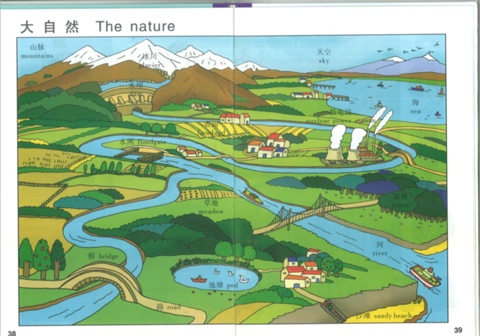The Nature in China

The scene above comes from a Chinese English-language instructional book for children, and I spotted it on BoingBoing in a post titled "Strange Nature Scene from Chinese Children's Book."
In addition to some elements that we'd consider familiar - mountains, sky, sandy beach, river - the scene includes some things that most Americans would not typically consider to be part of "The Nature": a nuclear power station seems most out-of-place, but there are also floodgates and a huge hydroelectric dam.
Fortunately, the first comment on this post came from a astute fellow named David Newland, who wrote
"This looks ironic only to New World folks who have had the privilege of imagining 'nature' as a space without people in it."Massive management" isn't necessarily an endorsement of building reactors in wilderness parks; rather, it's an argument for recognizing that nature also exists where people do, using that nature more wisely, and treating it better in our cities and towns. With all due respect to the Nature Conservancy, wilderness preserves in Wyoming or northern Maine aren't going to accomplish much in terms of solving global warming or slowing down the mass extinctions that are underway.
"Truth is, if nature has a future, it's as a massively managed space, whether we like it or not."
So in some ways, I find the "nature" scene depicted above more enlightened than the standard American post-industrial fantasy of wild, Edenic "nature." At least this scene demonstrates that Chinese children aren't receiving mixed messages about where their electricity or water comes from: that puts them ahead of a good many Western baby boomers who are spending their twilight years tilting at windmills.
But this picture, although more inclusive than most "nature" scenes, still leaves a lot out. Where's the seaside "dead zone" caused by nitrate runoff from those farms? Where do the hot isotopes from that nuclear plant go? Why aren't there any cars on those roads, spewing exhaust that smothers those quaint little villages in smog?
Chinese culture may be more clear-eyed than ours about how natural resources are harnessed for human habitats, but China's tremendous environmental problems indicate that there's still a cultural failure to appreciate the other side of the equation: how human economies affect natural (including human) resources. Nature may be abundant, but this picture doesn't acknowledge the real limits of that abundance - and China, of all places, needs to start recognizing those limits.
In that respect, this picture actually reminds me of a number of nineteenth-century allegorical paintings and political cartoons that depict the American frontier as a land of inexhaustible bounty. I'll discuss one of the more famous of those images, and how it demonstrates a similar view of nature as this contemporary Chinese illustration, in tomorrow's blog post.




No comments:
Post a Comment